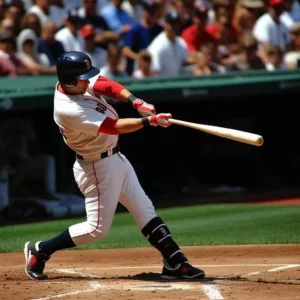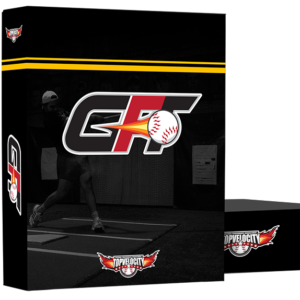Are you looking to improve the exit velocity for a 13 year old? You found a treasure trove of information.
The baseball field is indeed a crucible of determination, a vibrant arena where the invaluable traits of skill, strategy, and sheer physical prowess all meet. This field serves as the perfect platform for young, passionate athletes, especially boys who are 13 years of age. They have the ideal environment here to challenge their limits, enhancing their skills, and showcasing their raw talents to an appreciative audience. The journey of becoming a promising baseball player is truly rewarding and thrilling in itself.
A pivotal measure that showcases their hitting abilities is the concept of exit velocity. This metric can often seem elusive, so let's break it down. Exit velocity refers to the speed of the baseball as it launches off the bat after a successful hit. The question that naturally comes to the fore is, what qualifies as a good exit velocity for a 13-year-old boy? Are there any established benchmarks or standards that these young athletes should strive to achieve? For this, we delve into the fascinating world of baseball statistics, turning our focus specifically to the significance of the 56-65 mph range. This exploration promises to reveal crucial insights into the realm of youth baseball performance.
Understanding Exit Velocity
 Exit velocity is a term that resonates with the force and dynamism of baseball. At its core, it refers to the speed at which the ball leaves the bat post being hit. It's an element as simple as it sounds, but its implications on the game are profound. This metric is recorded in miles per hour (mph), a straightforward representation of speed that reflects a fascinating aspect of the batter's performance: their hitting strength.
Exit velocity is a term that resonates with the force and dynamism of baseball. At its core, it refers to the speed at which the ball leaves the bat post being hit. It's an element as simple as it sounds, but its implications on the game are profound. This metric is recorded in miles per hour (mph), a straightforward representation of speed that reflects a fascinating aspect of the batter's performance: their hitting strength.
This numerical value, the exit velocity, stands as a potent indicator of the batter's prowess. It's a tangible measure of the power encapsulated in each hit, serving as a reliable index of their physical strength and the efficacy of their technique. Conventionally, a higher exit velocity is synonymous with a better hit. This relationship, though generally consistent, can vary under certain circumstances. Regardless, a powerful hit resulting in a high exit velocity is a sight to behold on the field.
In the context of young athletes, specifically 13-year-old boys, exit velocity becomes a defining tool in their baseball journey. This measure takes a prominent place in their arsenal, both as a skill to master and a milestone to achieve. It becomes a matter of pride, an achievement that reflects their commitment to the sport and their relentless pursuit of improvement.
In this realm, an exit velocity falling within the 56-65 mph range is often seen as a mark of excellence. For a 13-year-old, reaching such speeds in their hits is not an easy feat. It's a testament to their hard work, technique refinement, and growing strength. This range sets the bar high, posing a challenge that pushes these young athletes to constantly enhance their performance.
Why 56-65 mph?
 The exit velocity range of 56-65 mph is frequently considered the sweet spot for young baseball aficionados, notably those aged 13 who participate in TopVelocity's highly rated GFT Hitting Program. This well-known program provides a painstakingly planned regimen that contains numerous training modules, each with a distinct focus. One of its primary goals is to emphasize proper hitting technique, which is essential for assuring consistent and strong hits.
The exit velocity range of 56-65 mph is frequently considered the sweet spot for young baseball aficionados, notably those aged 13 who participate in TopVelocity's highly rated GFT Hitting Program. This well-known program provides a painstakingly planned regimen that contains numerous training modules, each with a distinct focus. One of its primary goals is to emphasize proper hitting technique, which is essential for assuring consistent and strong hits.
Another important aspect of the GFT Hitting Program is strength development. This factor is critical since a player's raw physical power has a substantial impact on exit velocity. Strengthening workouts designed for these young athletes focus on improving core strength, forearm power, and wrist quickness. Each of these factors contributes to a player's ability to swing the bat with greater force, hence directly influencing the exit velocity.
The third pillar of the GFT Hitting Program is increasing the athlete's overall speed. In baseball, speed has several different meanings. It's not only about sprinting fast; it's about the speed of your swing, your reflexes, and your ability to maneuver quickly on the field. Any improvement in any of these areas can result in a noticeable increase in exit velocity.
The 56-65 mph range we've been talking about isn't arbitrary. It is not a random set of numbers; rather, it is the result of intensive research and careful observation of players in this age range. Exit velocity patterns have been discovered through research, and the data gathered has led to the formation of this range as an excellent benchmark for 13-year-old players. It establishes a clear and attainable goal for these young athletes, encouraging them to strive for more and, in turn, contributing to their development as well-rounded baseball players.
Training for Success
 A well-structured and methodical strategy to training is required to achieve and exceed the ideal range of exit velocity, namely the 56-65 mph range for 13-year-old boys. The procedure does not produce immediate results. It necessitates unrelenting dedication, a keen comprehension of the sport, and a desire to constantly develop. Every swing of the bat, every hit, and every run contributes to this trip, imbuing the young athlete with essential lessons and experiences.
A well-structured and methodical strategy to training is required to achieve and exceed the ideal range of exit velocity, namely the 56-65 mph range for 13-year-old boys. The procedure does not produce immediate results. It necessitates unrelenting dedication, a keen comprehension of the sport, and a desire to constantly develop. Every swing of the bat, every hit, and every run contributes to this trip, imbuing the young athlete with essential lessons and experiences.
The first, and maybe most important, part of any systematic technique is consistent practice. Baseball is no exception. Practice is the foundation upon which every skill is polished. A strong exit velocity at this age isn't something that happens by chance; it's the result of countless hours spent on the field, hitting ball after ball. Each practice session serves as a platform for these athletes to fine-tune their technique, identify their strengths, and work on their weaknesses.
Second, high-quality training is critical. The assistance of skilled coaches and mentors can considerably improve the training process's efficiency. A player's improvement can be significantly aided by expert counsel, constructive feedback, and specialized coaching approaches. This is especially true for complex talents such as reaching a high exit velocity, which necessitate the smooth integration of several aspects such as strength, speed, and technique.
Finally, and maybe most significantly, determination drives any major improvement. A strong will to succeed, a willingness to put in the effort, and a resilient attitude that accepts setbacks are the defining characteristics of a successful athlete. Regular training becomes a voyage of ongoing growth because of this determination.
TopVelocity's GFT Hitting Program excels in all of these areas. This complete program does more than just provide training; it provides young athletes with the required tools and knowledge, paving the path for them to improve their performance, hit outstanding exit velocities, and, most importantly, evolve as well-rounded athletes.
Beyond Exit Velocity
 As previously said, exit velocity is an important component of a baseball player's performance. It provides a measurable assessment of a player's hitting power, as well as a dependable indicator of their physical strength and technique. It is important to remember, however, that baseball is a multidimensional sport. While exit velocity is an important indicator, it is not the main factor of a player's total effectiveness.
As previously said, exit velocity is an important component of a baseball player's performance. It provides a measurable assessment of a player's hitting power, as well as a dependable indicator of their physical strength and technique. It is important to remember, however, that baseball is a multidimensional sport. While exit velocity is an important indicator, it is not the main factor of a player's total effectiveness.
Fielding is one such important feature that contributes significantly to a player's ability on the field. It entails skillfully intercepting the ball, correctly placing oneself, and immediately deciding on the best line of action. Fielding efficiently not only inhibits opponent runs, but also allows for quick turnover of play, maintaining the momentum on the player's side.
Running and throwing are two additional important aspects of the sport. Running speed can affect anything from the number of bases a player can secure to their defensive qualities on the field. Throwing, on the other hand, is essential for efficient fielding and ball transmission across the field. When it comes to stopping the opponent's runs, a strong, accurate throw can make all the difference.
Finally, and often forgotten, are the game's mental aspects. Psychological resilience, strategic thinking, decision-making under duress, and a positive mindset are all essential components of baseball success. They help a player grasp the game, make quick decisions, and deal with the inevitable highs and lows that come with it.
So, while having a decent exit velocity is a significant accomplishment for any young baseball player, it's vital to realize that it's only one element of the greater picture in becoming a successful baseball player. A well-rounded athlete succeeds not only in exit velocity, but also in fielding, sprinting, throwing, and mental approach to the game. After all, baseball is a game that necessitates the coordination of different skills and abilities.
How to Develop Elite Exit Velocity for a 13 Year Old
 So, what is an appropriate exit velocity for a 13-year-old boy? In the framework of TopVelocity's GFT Hitting Program, a speed range of 56-65 mph is deemed top-tier. It is important to emphasize, however, that this is a recommendation, not an absolute rule. Each player is unique, and what works for one may not work for another. Nonetheless, reaching and exceeding this range can be a powerful testimonial to a young player's talent, hard effort, and determination.
So, what is an appropriate exit velocity for a 13-year-old boy? In the framework of TopVelocity's GFT Hitting Program, a speed range of 56-65 mph is deemed top-tier. It is important to emphasize, however, that this is a recommendation, not an absolute rule. Each player is unique, and what works for one may not work for another. Nonetheless, reaching and exceeding this range can be a powerful testimonial to a young player's talent, hard effort, and determination.
It's important to remember that being a great baseball player is a marathon, not a sprint. It takes commitment, practice, and the appropriate coaching. TopVelocity's GFT Hitting Program is one such guiding force that can help young players fulfill their potential and reach new heights.




